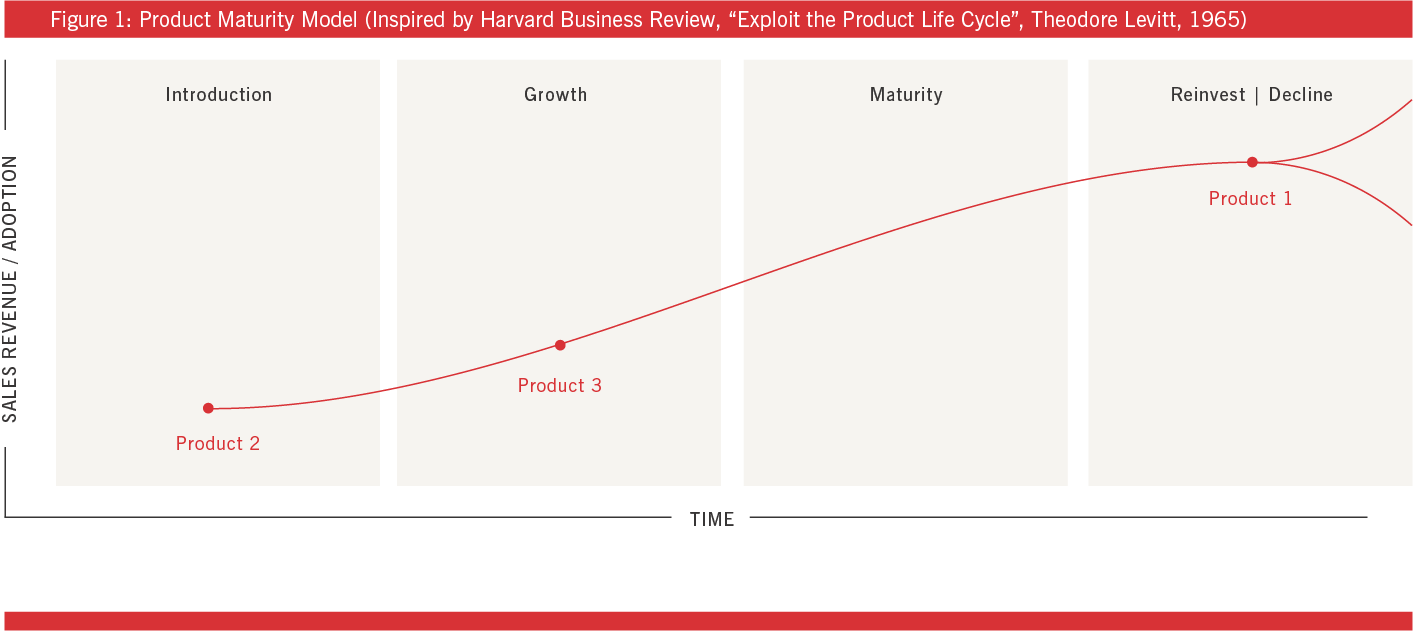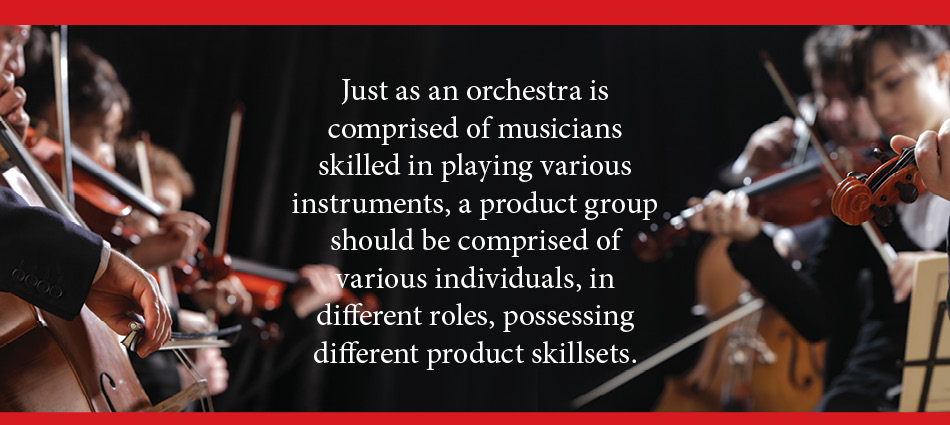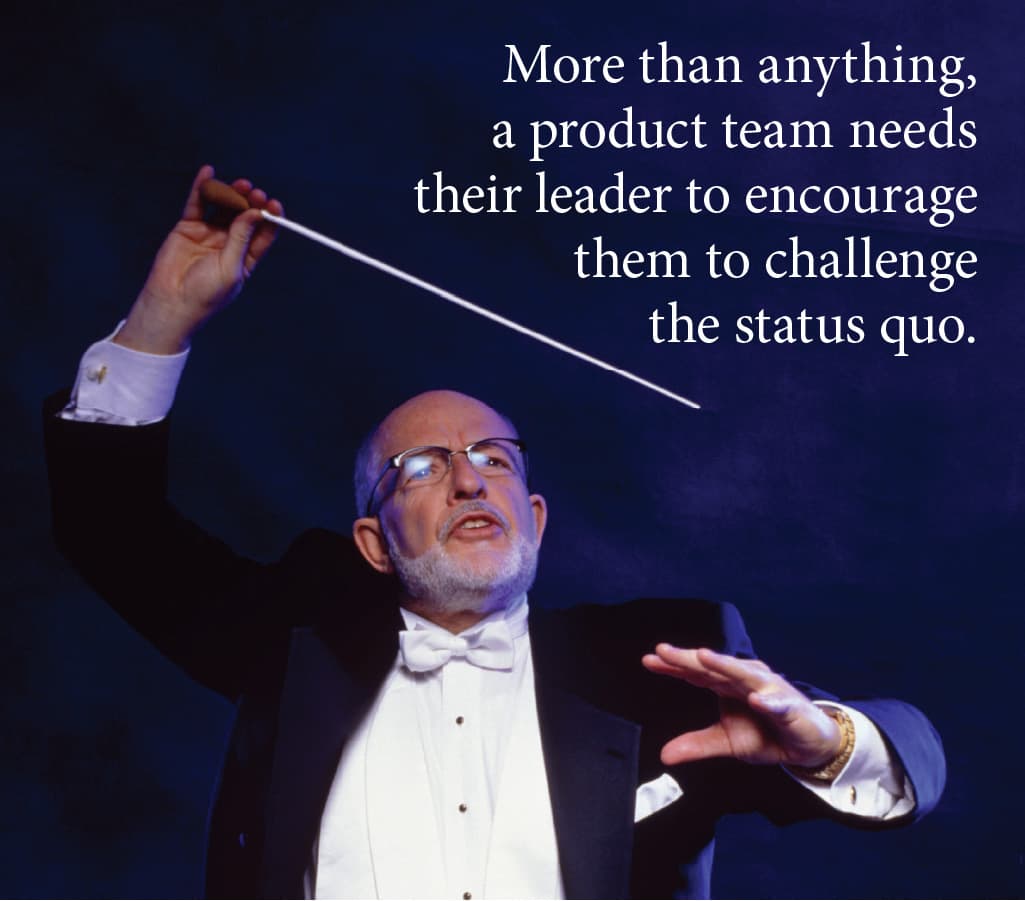To have an effective product team, the whole team must demonstrate proficiency in the following three areas:
- Expertise in all aspects of product management — from strategy to delivery
- Leading with courage
- Collaborative problem solving
Serving as foundational building blocks of successful product organizations, these competencies should be woven into the fabric of every product organization.
These concepts are not new, and it is easy to recognize their importance; however, it takes effort and time to establish this foundation. Consider how Jim Collins illustrates the Flywheel framework in his bestseller, “Good to Great.” Just as the Flywheel meets resistance at first during its initial spin, over time it gains momentum and begins running as a well-oiled machine. As Collin’s describes it, “Think of the transformation as a process of buildup followed by breakthrough.”

A. Proficient Team
Just as companies benchmark products against maturity models (e.g., Levitt’s maturity lifecycle model), companies should also regularly analyze their product team against capability models. Product teams should be proficient, equipped with the necessary skills, and demonstrate the core competencies necessary to perform.
Consider the makeup of your product team through the lens of their skills. Repurpose Levitt’s Maturity Product Curve (Figure 1) and consider where the individuals on your team fall on that curve. Junior product managers may fall in the “Introduction” stage, whereas your more experienced director level product managers fall within the “Maturity” stage. Regardless of where your team players fall, it is important to always invest in your people. However, if someone is on the downward slope, in the “Decline” stage, it is vital to quickly recognize that it’s time for a change. Keep your “A” players with “A” players. If you have any “B” players … invest in them to get them to be “A’s”.
A product group is responsible for carrying out various functions, and therefore product teams interact with nearly every other group in an organization from sales and marketing to customer support.
Let’s look at several roles the product group plays: research (customer and competitive), design, development, management, and marketing. No one role is more important than the others; rather each role has dependency on the others. It is critical that leadership recognizes the dependencies between roles and ensures egos are eliminated. Leadership needs to promote a culture of mutual respect by treating each role with equal importance.
Just as an orchestra is comprised of musicians skilled in playing various instruments, a product
group should be comprised of various individuals, in different roles, possessing different product skillsets. No one person has expert proficiency in every skill needed within a product organization. Therefore, it is unrealistic for leadership to expect one person to effectively create and manage products.
A product research role requires someone with deep analytical skills who is able to get into the details. A product marketing role requires someone with the ability to craft creative messaging invoking emotion and behaviors. Successful product management roles employ people with strong capabilities in assessing market opportunities and determining product value.
Although each role within a product group requires specific capabilities to excel, the whole team should demonstrate the following capabilities:

Solution Savviness
Approach problems by providing a holistic solution — eliminate the thought that one product will solve your customer’s problems. Remember, no one person or product should be responsible for solving problems; solutions should be owned by all.
Teamwork
Leaders rise up in every team. Effective leaders know when
to push and pull the levers of control. Leaders should not control the solution of a problem, rather know how to leverage their team’s unique strengths to get things done through others. Always keeping deadlines in mind and managing against your product roadmap.
Adaptability
The role of product manager hasn’t changed, but the delivery mechanisms have evolved with emerging technology. Think of it in this way: a carpenter who built furniture 100 years ago was limited to using a hammer and nails. A carpenter today has a nail gun to expedite the process. A tool or mechanism that worked well five years ago may not be the most effective tool for the scenario you face today. Keep up to date with emerging tools and technology to fulfill your responsibilities.
Communicating with Influence
Product people need to have sales skills. They are the ones ideating new products or enhancements. They must validate their ideas through research and development and proof of concepts, to get buy-in from the C-suite (providing financial support) and the development teams (building or enhancing products).
Curiosity
Curiosity is a trait that cannot be faked. The best product managers don’t accept the status quo. They are self-driven to stay up-to-date on the latest product and industry trends. They are life-long learners.
If the opportunity to hire arises, it is critical to ensure candidates have demonstrated success in the skills specific to excelling in their roles. It is equally important to seek candidates who possess the five capabilities stated above, as these should not be negotiable for any role in a product group.

B. Courageous Leadership
Several studies have demonstrated direct correlation between employee satisfaction and relationship with management. One study conducted late last year by Randstad found more than 80% of respondents believed that their relationship with their direct supervisor had impacts on how “happy” they were with their job. How does this relate to product? A company’s core business centers around products and services they offer; for that reason, leaders in a product group should be held to very high standards.
The greatest leaders possess the following well-known leadership traits: courage, inclusiveness, and a supportive and motivating attitude. The most critical trait for product leaders is courage.
More than anything a product team needs their leader to encourage them to challenge the status quo. A product leader should exhibit courage in taking risks. Think of theory versus practice. Some product ideas sound good, but unless the proof of concept (POC) suggests the green light to move forward, those ideas should not be pursued. Do not consider unexpected results of a POC as a failure, because it is just as important to know what not to pursue as it is to know what to pursue.
Remember, a solution should be owned by a team, not one person or one product. Have the courage to step away. You have a team. Empower your team to solve problems — this creates a culture of inclusiveness and innovation. Have the courage to listen. The easiest way to listen to your employees is by implementing a bottom-up innovation idea funnel. Your team is empowered to showcase their ideas. The results can be profitable new products.

C. Collaborative Problem Solving
Great product leaders relentlessly drive to improve team performance. High-performing product teams build and maintain their strength by celebrating and reinforcing a participative culture in problem solving. It is human nature for people to want to help (i.e., we feel a sense of gratification when we are able to be part of a solution). There are a few ingredients that must be present to permit collaborative problem solving.
First, a team must have the desire to identify problems and ability to deliver solutions. Second, leadership needs the courage to facilitate innovation before validation. Finally, teams should leverage the unique skills each product team member has to find the solution. Remember, each member of the product team brings a different set of tools to the table, recognize the need for the entire toolbox, not just the tools on your belt.
Finally, don’t let the red tape of process cripple the ability to solve problems. Process is important, but it is not everything. Roles are important, but don’t let egos get in the way of working together to find solutions to problems. Ensure your team places emphasis on solving problems through presenting holistic solutions through products.
Closing
Creating efficiencies in your product organization is not going to happen overnight. It takes commitment from the entire team — the approach is both top-down and bottom-up. Due to the variety that exists within a product team, each member of the team brings something different to the table. If someone is not contributing, figure out why, and then invest in them. They may not be in the role that matches their capability.
At the end of the day, your responsibility is to deliver profitable products. Having an effective product team will get you there. World renowned product practitioner Marty Cagen says, “Everything starts with people, but the process is what enables these people to consistently produce inspiring and successful products.”
